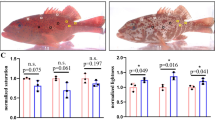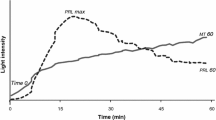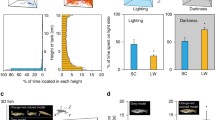Summary
The skin colour of the cichlid teleost Sarotherodon mossambicus adapted rapidly to changes in background colour. The physiological adaptation was associated with morphological changes in the dermis. Differences in the dermis were found between fish adapted to a black or white background for 14 days. Number and size of the melanophores as well as the amount of pigment in the cytoplasm of the melanophores were significantly increased in fish adapted to a black background. Changes in the dermis parallelled changes in the state of activity of the two endocrine cell types in the pars intermedia of the pituitary. Both the PAS positive cells and the MSH producing cells were more active when the fish were exposed to a black rather than a white background. Fish continuously infused with α-MSH, using an osmotic minipump, had more melanophore cytoplasm and pigment per dermis surface unit area than untreated fish. The activity of the MSH cells in MSH-infused fish exposed to a black background was reduced to a level comparable to the MSH cell activity of untreated fish on a white background. α-MSH treated fish that were exposed to a white background had many disintegrating MSH cells. These findings point to inactivation of these cells by exogenous α-MSH. The activity of the PAS positive cells was not influenced by treatment with α-MSH.
Similar content being viewed by others
References
Abboth FS (1973) Endocrine regulation of pigmentation in fish. Am Zool 13:885–894
Baker BI (1972) The cellular source of melanocyte-stimulating hormone in Anguilla pituitary. Gen Comp Endocrinol 19:515–521
Baker BI, Ball JN (1970) Background adaptation and pituitary in teleost fishes. J Endocrinol 48:XXVI-XXVII
Fingerman M (1970) Comparative physiology: Chromatophores. Am Rev Physiol 32:345–372
Fujii R (1969) Chromatophores and pigments. In: Hoar WS, Randall DJ (eds) Fish physiology. Vol III. Academic Press, New York London, pp 307–353
Hogben L, Slome D (1936) The pigmentary effector system VIII: The dual receptive mechanism of the amphibian background response. Proc Soc Ser B 120:158–173
Ide H (1974) Further studies on the hormonal control of melanophores and iridophores isolated from bullfrog tadpoles. Gen Comp Endocrinol 24:341–345
Kawauchi H, Muramoto K (1979) Isolation and primary structure of melanotropins from salmon pituitary glands. Int J Peptide Protein Res 14:373–374
Kosto B, Pickford GE (1957) Further studies of the hormonal induction of melanogenesis in killifish, Fundulus heteroclitus. Endocrinology 64:869–881
Malo-Michele M (1977) Réactions cytologiques de la pars intermedia de l'hypofyse de la saupe, Boops salpa L. (poisson téléostéen, Sparidae) aux variations de la couleur de fond et de l'illumination. Gen Comp Endocrinol 31:343–349
Novales RR (1973) Discussion of “Endocrine regulation of pigmentation” by Frank S Abboth. Am Zool 13:895–897
Odiore JM (1957) Color changes. In: Brown ME (ed) The physiology of fishes, Vol 2. Academic Press, New York London, pp 387–401
Olivereau M (1971) Intermedin production by the lead-haematoxyline positive cells of the pars intermedia of the eel: new evidence and hypothalamic control. C R Acad Sci Paris Ser D 272:102–105
Olivereau M (1972) Action de la reserpine chez l'anguille: II. Effet sur la pigmentation et le lobe intermédiaire. Comparaison avec l'effet de l'adaptation sur un fond noir. Z Anat Entwickl Gesch 137:30–46
Pickford GE, Kosto B (1957) Hormonal induction of melanogenesis in hypophysectomized killifish (Fundulus heteroclitus). Endocrinology 61:177–196
Thornton VF, Howe C (1974) The effect of change of background on the ultrastructure of the pars intermedia of the eel (Anguilla anguilla). Cell Tissue Res 151:103–115
Van Eys GJJM (1980a) Structural changes in the pars intermedia of the cichlid teleost Sarotherodon mossambicus as a result of background adaptation and illumination. I: The MSH-producing cells. Cell Tissue Res 208:99–110
Van Eys GJJM (1980b) Structural changes in the pars intermedia of the cichlid teleost Sarotherodon mossambicus as a result of background adaptation and illumination. II: The PAS positive cells. Cell Tissue Res 210:171–179
Waring H (1963) Color change mechanism of cold-blooded vertebrates. Academic Press, New York London
Weibel ER, Paumgartner D (1978) Integrated stereological and biochemical studies on hepatocytic membranes. II. Correction of section thickness effect on volume and surface density estimates. J Cell Biol 77:584–597
Wilson JF, Dodd JM (1973) The role of melanophore-stimulating hormone in melanogenesis in the dogfish, Scyliorhinus canicula L. J Endocrinol 58:685–686
Author information
Authors and Affiliations
Rights and permissions
About this article
Cite this article
van Eys, G.J.J.M., Peters, P.T.W. Evidence for a direct role of α-MSH in morphological background adaptation of the skin in Sarotherodon mossambicus . Cell Tissue Res. 217, 361–372 (1981). https://doi.org/10.1007/BF00233586
Accepted:
Issue Date:
DOI: https://doi.org/10.1007/BF00233586




